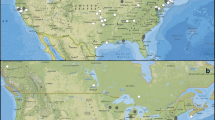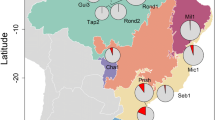Abstract
Ticks are among the best studied parasitic groups as they spread important pathogens of medical and veterinary importance worldwide. Migratory birds can play an important role in transporting ticks infected with pathogens across wide geographic regions. It is therefore important to understand which factors promote tick parasitism rates across their avian hosts and the associated potential for disease spread. Here, we identified the host attributes of infestation probability of ticks from the genus Amblyomma in 955 birds from Pantanal, Brazil. Infestation rates exhibited considerable variation across the 129 avian species surveyed and were explained by both host ecological traits and evolutionary history. The probability of an individual bird being infested with immature ticks (larvae and/or nymphs) was higher across resident bird species that forage at ground level and during the wet season. Bird species that feed on vertebrates were less likely to be infested by ticks. Other ecological traits known to promote tick exposure (age, body mass, social behavior, and sex) did not predict infestation probability. Our findings demonstrate that tick occurrence in Pantanal birds is determined by avian host attributes, but tick occurrence throughout the year constrains exposure to host-seeking ticks. Moreover, the ecology of the avian host might prevent the potential spread of tick-borne diseases outside Pantanal as migratory hosts are likely less infested by ticks.




Similar content being viewed by others
References
Alexander RD (1974) The evolution of social behavior. Annu Rev Ecol Syst 5:325–383
Allen T, Murray KA, Zambrana-Torrelio C et al (2017) Global hotspots and correlates of emerging zoonotic diseases. Nat Commun 8:1124
Barbieri ARM, Szabó MPJ, Costa FB et al (2019) Species richness and seasonal dynamics of ticks with notes on rickettsial infection in a Natural Park of the Cerrado biome in Brazil. Ticks Tick Borne Dis 10:442–453
Barros-Battesti DM, Arzua, M, Bechara GH (2006) Carrapatos de importância médico-veterinária da Região Neotropical: Um guia ilustrado para identificação de espécies. Vox/ICTTD-3/Butantan, São Paulo
Brinkerhoff RJ, Dang L, Streby HM, Gimpel M (2019) Life history characteristics of birds influence patterns of tick parasitism. Infect Ecol Epidemiol 9(1):1547096. https://doi.org/10.1080/20008686.2018.1547096
Dantas-Torres F, Chomel BB, Otranto D (2012) Ticks and tick-borne diseases: a One Health perspective. Trends Parasitol 28:437–466
del Hoyo J, Elliott A, Sargatal J, Christie DA, Kirwan G (2019) Handbook of the birds of the world alive. Lynx Edicions, Barcelona
Dingler RJ, Wright SA, Donohue AM, Macedo PA, Foley JE (2014) Surveillance for Ixodes pacificus and the tick-borne pathogens Anaplasma phagocytophilum and Borrelia burgdorferi in birds from California’s Inner Coast Range. Ticks Tick Borne Dis 5:436445
Eisen L, Eisen RJ, Lane RS (2004) The roles of birds, lizards, and rodents as hosts for the western black-legged tick Ixodes pacificus. J Vector Ecol 29(2):295–308
Elfving K, Olsen B, Bergstorm S, Waldenstrom J, Lundkvist A, Sjostedt A, Mejlon H, Nilsson K (2010) Dissemination of spotted fever Rickettsia agents in Europe by migrating birds. PLoS ONE 5:e8572. https://doi.org/10.1371/journal.pone.0008572
Esser HJ, Herre EA, Blüthgen N, Loiaza JR, Bermúdez SE, Jansen PA (2016) Host specificity in a diverse Neotropical tick community: an assessment using quantitative network analysis and host phylogeny. Parasite Vectors 9:372. https://doi.org/10.1186/s13071-016-1655-6
Felsenstein J (1985) Phylogenies and the comparative method. Am Nat 125:1–15
Guglielmone AA, Estrada-Pena A, Keirans JE, Robbins RG (2003) Ticks (Acari: Ixodidae) of the neotropical zoogeographic region. Atalanta, Houten
Hackett SJ, Kimball RT, Reddy S, Bowie RC et al (2008) A phylogenomic study of birds reveals their evolutionary history. Science 320:1763–1768
Hadfield JD (2010) MCMC methods for multi-response generalized linear mixed models: the MCMCglmm R package. J Stat Softw 33:1–22
Hadfield JD (2012) MCMCglmm course notes. (https://stat.ethz.ch/CRAN/web/packages/MCMCglmm/index.html)
Hamer SA, Goldberg TL, Kitron UD et al (2012) Wild birds and urban ecology of ticks and tick-borne pathogens, Chicago, Illinois, USA, 2005–2010. Emerg Infect Dis 18:1589–1595
Hasle G (2013) Transport of ixodid ticks and tick-borne pathogens by migratory birds. Cell Infect Microbiol 3:48
Hönig V, Svec P, Halas P et al (2015) Ticks and tick-borne pathogens in South Bohemia (Czech Republic)-Spatial variability in Ixodes ricinus abundance, Borrelia burgdorferi and tick-borne encephalitis virus prevalence. Ticks Tick Borne Dis 6:559–567
Ives AR (2018) Mixed and phylogenetic models: a conceptual introduction to correlated data. https://leanpub.com/correlateddata.
Ives AR, Garland T (2014) Phylogenetic regression for binary dependent variables. In: Garamszegi LZ (ed) Modern phylogenetic comparative methods and their application in evolutionary biology. Springer, Berlin, pp 231–261
Jetz W, Thomas GH, Joy JB, Hartmann K, Mooers AO (2012) The global diversity of birds in space and time. Nature 491:444–448
Labruna MB, Kasai N, Ferreira F, Faccini JLH, Gennari SM (2002) Seasonal dynamics of ticks (Acari: Ixodidae) on horses in the state of São Paulo Brazil. Vet Parasitol 105:65–77
Labruna MB, Terassini FA, Camargo LM (2009) Notes on population dynamics of Amblyomma ticks (Acari: Ixodidae) in Brazil. J Parasitol 95:1016–1018
Loss SR, Noden BH, Hamer GL, Hamer SA (2016) A quantitative synthesis of the role of birds in carrying ticks and tick-borne pathogens in North America. Oecologia 182:947–959
Luz HR, Faccini JLH (2013) Ticks on Brazilian birds: overview. In: Ruiz L, Iglesias F (eds) Birds: evolution and behavior, breeding strategies, migration and spread of disease. Nova Science Publisher, New York, pp 97–126
Martins TF, Onofrio VC, Barros-Battesti DM, Labruna MB (2010) Nymphs of the genus Amblyomma (Acari: Ixodidae) of Brazil: descriptions, redescriptions, and identification key. Ticks Tick Borne Dis 1:75–99
Miller MJ, Esser HJ, Loaiza JR, Herre EA, Aguilar C, Quintero D et al (2016) Molecular ecological insights into neotropical bird-tick interactions. PLoS ONE 11(5):e0155989. https://doi.org/10.1371/journal.pone.0155989
Mukherjee N, Beati L, Sellers M, Burton L, Adamson S, Robbins RG, Moore F, Karim S (2014) Importation of exotic ticks and tickborne spotted fever group rickettsiae into the United States by migrating songbirds. Ticks Tick Borne Dis 5:127–134
Münkemüller T, Lavergne S, Bzeznik B, Dray S, Jombart T, Schiffers K, Thuiller W (2012) How to measure and test phylogenetic signal. Methods Ecol Evol 3:743–756
Nava S, Venzal JM, González-Acuña D, Martins TF, Guglielmone AA (2017) Ticks of the Southern Cone of America: diagnosis, distribution and hosts with taxonomy, ecology and sanitary importance. Elsevier, London
Newman EA, Eisen L, Eisen RJ, Federova N, Hasty JM, Vaughn C, Lane RS (2015) Borrelia burgdorferi sensu lato spirochetes in wild birds in northwestern California: associations with ecological factors, bird behavior, and tick infestation. PLoS ONE 10:e0118146. https://doi.org/10.1371/journal.pone.0118146
Ogden NH, Lindsay LR, Hanincová K et al (2008) Role of migratory birds in introduction and range expansion of Ixodes scapularis ticks and of Borrelia burgdorferi and Anaplasma phagocytophilum in Canada. Appl Environ Microbiol 74:1780–1790
Ogrzewalska M, Pinter A (2016) Ticks (Acari: Ixodidae) as ectoparasites of Brazilian wild birds and their association with rickettsial diseases. Braz J Vet Res Anim Sci 53:1–31
Pagel M (1999) Inferring the historical patterns of biological evolution. Nature 401:877–884
Pinho J, Aragona M, Hakamada K, Marini MA (2017) Migration patterns and seasonal forest use by birds in the Brazilian Pantanal. Bird Conserv Int 27:371–387
R Development Core Team (2020) R: a language and environment for statistical computing. R Foundation for Statistical Computing, Vienna. https://www.R-project.org
Rizzoli A, Tagliapietra V, Cagnacci F, Marini G, Arnoldi D, Rosso F, Rosà R (2019) Parasites and wildlife in a changing world: the vector-host- pathogen interaction as a learning case. Int J Parasitol Parasites Wildl 9:394–401
Schneider SC, Parker CM, Miller JR, Fredericks LP, Allan BF (2015) Assessing the contribution of songbirds to the movement of ticks and Borrelia burgdorferi in the midwestern United States during fall migration. EcoHealth 12:164–173
Tabor AE, Ali A, Rehman G, Garcia GR, Zangirolamo AF, Malardo T, Jonsson NN (2017) Cattle tick Rhipicephalus microplus-host interface: a review of resistant and susceptible host responses. Front Cell Infect Microbiol 7:506. https://doi.org/10.3389/fcimb.2017.00506
Wilman H, Belmaker J, Simpson J, de la Rosa C, Rivadeneira MM, Jetz W (2014) EltonTraits 1.0: species-level foraging attributes of the world's birds and mammals. Ecology 95:2027–2027
Acknowledgements
This study was supported by grants from the Pantanal Research Center (CPP), Instituto Nacional de Ciências e Tecnologia em Áreas Úmidas (INAU), and Ministério de Ciências e Tecnologia (MCT). During the project, AF was supported by a postdoctoral fellowship (PNPD scholarship) from Coordenação de Aperfeiçoamento de Pessoal de Nível Superior (CAPES).
Author information
Authors and Affiliations
Corresponding author
Additional information
Publisher's Note
Springer Nature remains neutral with regard to jurisdictional claims in published maps and institutional affiliations.
Electronic supplementary material
Below is the link to the electronic supplementary material.
Rights and permissions
About this article
Cite this article
Fecchio, A., Martins, T.F., Bell, J.A. et al. Host movement and time of year influence tick parasitism in Pantanal birds. Exp Appl Acarol 82, 125–135 (2020). https://doi.org/10.1007/s10493-020-00530-1
Received:
Accepted:
Published:
Issue Date:
DOI: https://doi.org/10.1007/s10493-020-00530-1




